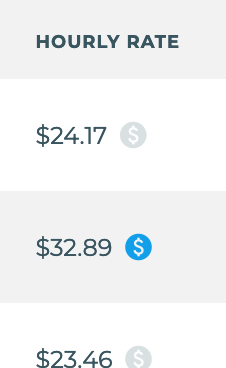Performance Bonus Rate Type and Jobs
This is a beta feature for early adopters and may change.
Jobs and timesheets which are tracked with the Performance rate type allow you to pay your employees a base hourly rate, with a performance bonus reward when they perform well.
In order to measure performance, you need to provide a unit rate for the job and track the units worked per-employee. Tracking a performance job works much like a contract job.
This feature is not available in legacy reports.
Thresholds
The performance ‘threshold’ is based on the employee’s personal hourly rate, or if they don’t have one, the minimum wage.
If multiple hourly rates are applicable during a calculation period, the performance threshold hourly rate will be the highest rate, ensuring no employee can earn below their agreed hourly rate.
Calculation period
Performance is calculated per-timesheet but a bonus is only entitled if an employee’s performance is greater than their normal hourly rate. Their performance is averaged over your organisation’s Performance Bonus calculation period, which can be changed in Tātou Office under ⚙️ → Settings → Entitlements.
Some industries refer to this type of calculation as “hourly incentive”.
Average performance hourly rate
Using the calculation period, all of the employee’s unit-based earnings are averaged to produce a unit hourly rate. This is compared with their base hourly rate to determine whether or not an employee is entitled a performance bonus. It is also a useful metric to gauge performance over the calculation period.
Average unit hourly rate = (sum of units worked x unit rate) / (sum of performance hours worked)
You can see an employee’s average performance unit hourly rate for a pay period in their profile page → timesheets.
Note: if your performance calculation period is shorter than your pay period you may have multiple calculations within a single pay period. In this case, the average unit hourly rate is averaged across these calculation periods to provide a single performance metric.
Examples
Example 1: Brian
Brian has an hourly rate of $25 and works Monday, Tuesday and Friday.
Day | Hours | Hourly rate | Hourly earnings | Units | Unit rate | Hypothetical unit earnings | Performance met? |
|---|---|---|---|---|---|---|---|
Monday | 8 | 25 | $200 | 600 | 0.4 | $240 |
|
Tuesday | 6 | 25 | $150 | 600 | 0.1 | $60 |
|
Friday | 10 | 25 | $250 | 900 | 0.3 | $270 |
|
Summary | 24 | $600 | $570 |
|
Resulting in an average performance hourly rate of $23.75 ($570 / 24), which is below his base hourly rate of $25. No performance bonus was earned.
Example 2: Charlie
Charlie has an hourly rate of $25 and works Monday, Tuesday, Wednesday and Friday.
Day | Hours | Hourly rate | Hourly earnings | Units | Unit rate | Hypothetical unit earnings | Performance met? |
|---|---|---|---|---|---|---|---|
Monday | 8 | 25 | $200 | 600 | 0.4 | $240 |
|
Tuesday | 6 | 25 | $150 | 600 | 0.1 | $60 |
|
Wednesday | 8 | 25 | $200 | 650 | 0.4 | $260 |
|
Friday | 10 | 25 | $250 | 900 | 0.3 | $270 |
|
Summary | 32 | $800 | $830 |
|
Resulting in an average performance hourly rate of $25.9375 ($830 / 32), which is above her base hourly rate of $25. A performance bonus of $30 ($830 - $800) was earned.
Job cost
Performance is assessed per-timesheet, which means we know which timesheets were above their performance threshold, and by how much.
This ensures that the performance costs attributed to each job is directly related to the employee performance for that job. For example an employee worked 20% above their threshold in a morning job, and 10% above in an afternoon job, the morning job would cost 20% more, and the afternoon job 10% more.
If the employee’s average performance for the calculation period did not meet the threshold, then no bonuses are earned and no performance costs are incurred, even if some of their timesheets were above their performance threshold.

You can see this in action by viewing a job’s timesheets and looking at the Hourly rate column. The hourly rate shown is the Hypothetical unit hourly rate (see examples above) so you can identify each timesheet’s performance.
The icon colour indicates whether the employee’s average performance exceeded their threshold or not.
Timesheets only incur performance cost when the timesheet performance AND the employee’s average performance exceeded their threshold.
